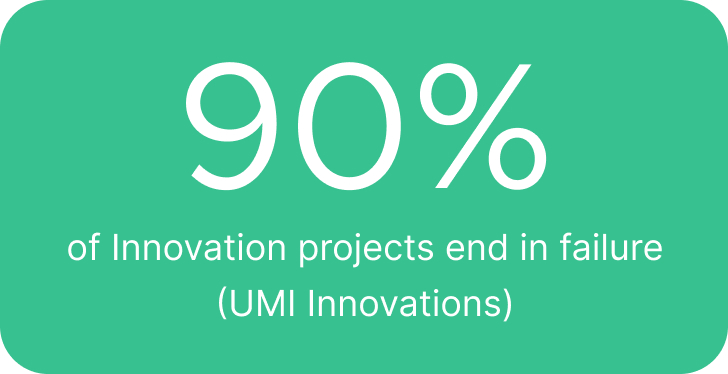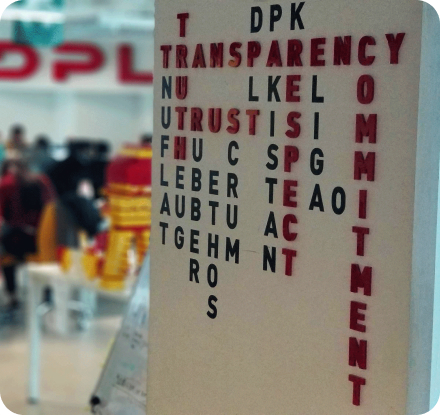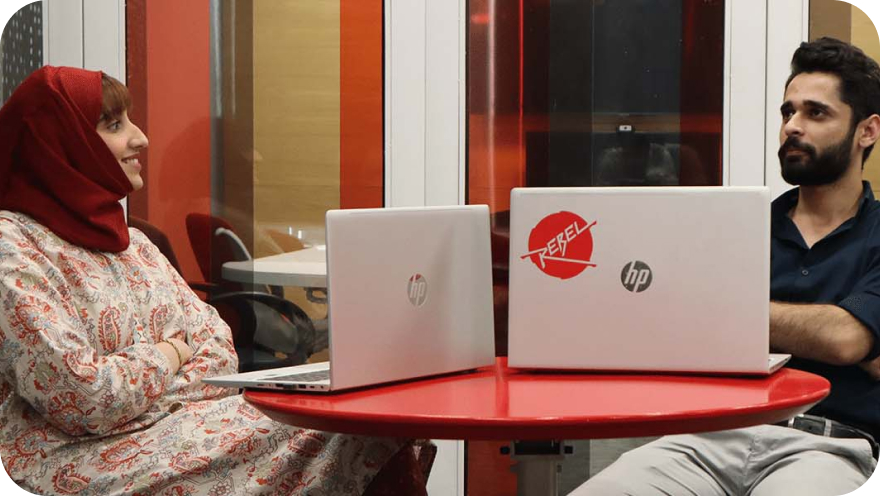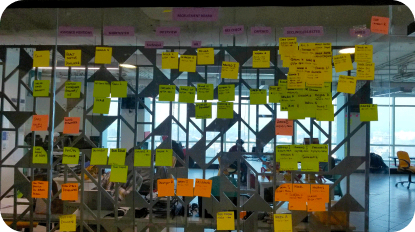Abstract
“Innovate or die” is neither a catchphrase nor a promotional gimmick for IT companies to lure new business. It is a fact that businesses need to embrace in order to succeed and withstand the growing competition across industry verticals.
With the help of this whitepaper, decision makers will discover the true meaning of innovation, its need, and why DPL’s ‘Innovation as a Service’ is the only approach for ensuring success in the years to come.
What is Innovation?
Innovation (noun)-
A new idea, method, or device: NOVELTY
-
The introduction of something new
Elaborating on the dictionary definition of the word, McKinsey & Company[1] defined this best as “the ability to conceive, develop, deliver, and scale new products, services, processes, and business models for customers.” The term further extends to improving or replacing products, processes, and services in order to create new value.
However, innovation is not the same as creativity despite both terms being used interchangeably. Whereas creativity may be limited to coming up with new ideas, innovation goes beyond that to implementing these ideas in order to solve customer pain points and create value.
Moreover, innovation does not need to be extravagant or make headlines. Rather than major breakthroughs, innovative initiatives can be as simple as upgrading customer service or adding new features to an existing product. As long as they effectively solve problems, innovations are considered successful.
Another factor determining the success of innovative initiatives is their types. According to Harvard Business School, organizations need to consider and carry out two types of innovation: sustaining innovation and disruptive innovation
Sustaining innovation encompasses initiatives that improve an organization’s processes and technologies to ensure its position at the top of its market. Meanwhile, disruptive innovation occurs when companies claim a segment of an existing market, or create an additional segment where they can accommodate a new customer base.
Together, both forms of innovation in business enable business growth, support organizations’ competitiveness, and protect against other companies affecting its standing.


The Need for Innovation in 2024 and Beyond
Combined, a solid customer base, great product, growing sales, and an effective supply chain have the power to trick businesses into a sedentary stance. After all, everything is going as planned if not better. However, this puts them at risk; especially as their industry is constantly changing around them.
By delaying innovation, organizations are in danger of becoming irrelevant, lowering productivity, losing customers, and eventually going out of business. This was the case of many leading brands such as Kodak, Blockbuster, Toys R Us, and Sears.
Kodak was a name once associated with everything related to photography. Yet despite producing the world’s first digital camera, it still focused on photography film and eventually filed for bankruptcy in 2012. Similarly, Blockbuster decided against going digital as it would be too expensive. Sticking to its physical stores when Netflix was shipping DVDs to consumers’ homes made it shut down in 2014
Famous kids toy retailer Toys R Us is another leading brand that missed the innovation bandwagon. By signing a 10-year contract with Amazon to be its exclusive toys vendor, it missed on the opportunity to develop its own eCommerce presence. Especially since Amazon allowed other toy stores to sell on its site.
As for Sears, it failed to adapt to consumers’ changing tastes. It also stayed stagnant while the market moved away from the traditional general store model, welcomed smaller boutiques and discount stores, and embraced digital shopping.
These are just some of the examples that justify the phrase ‘innovate or die’. Therefore, it is best to embrace innovation in today’s highly competitive and constantly evolving industry, and begin reaping benefits such as:
Initiate your digital transformation today
Contact UsUnfortunately, Innovation May Allude Many Businesses
Despite the resources and effort businesses invest in innovative initiatives, only 10% are likely to succeed.[1] Even for companies that believe in failing fast, this can be too big a loss to recover quickly from, especially in the case of startups. Even if innovation failure does not directly impact an organization’s bottom line, it can affect its operational efficiency.

So, what causes innovation to fail? The obvious reasons tend to be low team motivation, not understanding customers’ needs, misaligned initiatives, and lack of preparation. However, the focus of this paper is to highlight what most organizations miss instead. Therefore, the main reasons explained in this section are:
- Taking on the wrong approach
- Not thinking long term
- Lack of innovation mindset, structure, and processes
- Fear of failure
1) Taking on the wrong approach
There are several misconceptions driving organizations to approach innovation all wrong.
- Most organizations confuse innovation with invention. The latter, however, remains on the shelf by definition. Therefore, it may not generate revenue for its creator.
- Some associate invention with a target market. This too if a wrong approach, especially when the target market is analyzed based on past behavior.
- Pre-innovation homework is limited to studying past and historic market trends. This approach fails to consider the impacts of the organization’s next project on their market, which is a must as innovation focuses on the future.

- As organizations are blinded by these misconceptions, they miss out on how the market will react to an innovation.
- The right approach here is to carry out market-centered research with the question: will the market adopt the new innovation the organization has in mind? Moreover, there needs to be both a market focus and a product focus for the project. Having a market focus means identifying the pain points of the target market and how the business can orient itself towards it. Meanwhile, a product focus entail defining the most minimal yet sufficient solution to meeting those needs.
2) Lack of innovation mindset, structure, and processes
For innovation to succeed, organizations need to have the right employee mindset as well as structure and process in its innovation strategy.
An innovation mindset refers to a set of attitudes, beliefs, and behaviors that foster a culture of creativity, adaptability, and continuous improvement within individuals and organizations. There are certain telltale signs of employees having developed this mindset, including:

- Curiosity, or a genuine interest in exploring new ideas and understanding the world around them
- Openness to change which means embracing and seeking out opportunities for positive change rather than resisting it
- Risk taking, that is the willingness to take calculated risks and experiment while fully understanding that failure is a part of the learning process
- Problem-solving orientation which means viewing challenges as opportunities for creative problem-solving rather than insurmountable obstacles
- Customer-centric thinking or prioritizing the needs and preferences of end-users in the development of products or solutions.
- Continuous learning ensuring a commitment to ongoing personal and professional development, and staying informed about industry trends and emerging technologies
- Adaptability or being flexible and open-minded in the face of change to better adapt strategies based on feedback and evolving circumstances
- Visionary thinking which entails focusing on long-term goals and envisioning possibilities beyond the current state
For innovation to succeed, organizations need to have the right employee mindset as well as structure and process in its innovation strategy.
An innovation mindset refers to a set of attitudes, beliefs, and behaviors that foster a culture of creativity, adaptability, and continuous improvement within individuals and organizations. There are certain telltale signs of employees having developed this mindset, including:

A Potential Startup Unicorn Building Smart Communities with Connected Apartments

Without these traits, employees do not have the mindset to solve the organization’s innovation problem and create something new. Therefore, it is imperative to cultivate the innovation mindset, starting from the top and then across every level of the business.
As for the innovation process, by definition it is the systematic implementation of existing and/or new findings to create marketable solutions. To be more precise, it is a process that is systematic, future-oriented, user-integrated, and holistic. That way, it takes into consideration long-term goals as well as the organization’s structure and culture.
With a structured innovation process, an organization’s internal organizational structure can adapt and ensure the success of its efforts. The responsibilities of members of the workforce, management tasks, and teams’ composition undergo shifts to support the innovation process. While this may sound like a complete overhaul, it is not so. A new structure does not necessarily need to be created; instead, a new procedure or new team composition may suffice.
Moreover, innovation processes create a clear framework as to how ideas are introduced, how they will be pursued, and how they will end up in the market. It further creates opportunities to break the barriers to innovation while establishing effective innovative management.
Therefore, it is clear how the absence of an innovation structure and process may derail innovative initiatives and lead to their failure.
3) Prioritizing technology over solutions
Technology is a catalyst for innovation, enabling the creation of novel solutions and transforming industries. It accelerates idea generation, facilitates rapid prototyping, and enhances communication. Unfortunately, businesses may make the mistake of prioritizing new technology over the goals for using it in the first place.
Yes, technology may be effective in creating new
solutions for customers’ pain points. However, this is not always true. There are many ways to address consumer problems without resorting to high tech. Therefore, business need to be able to analyze their needs and take into consideration every opportunity presented to them – including those where technology may not be needed.
4) Fear of failure
The fear of failure can put an end to companies’ innovation by creating a risk-averse culture. This issue discourages experimentation and limits creativity as individuals and teams become hesitant to explore new ideas. Moreover, it takes its toll on the organization’s adaptability and inhibits the learning opportunities that arise from setbacks, which, in turn, negative impact the iterative process essential for successful innovation.

Employees’ low confidence and reluctance to try something new can be a huge factor in the failure of innovation. However, this can be remedied by helping them develop the innovation mindset as well as by providing them complementary assets. The latter include digital whiteboards to help detect mistakes easily, and even team members or managers who can encourage them and boost their morale.
The Problem with ‘Buying’ Innovation
Employees’ low confidence and reluctance to try something new can be a huge factor in the failure of innovation. However, this can be remedied by helping them develop the innovation mindset as well as by providing them complementary assets. The latter include digital whiteboards to help detect mistakes easily, and even team members or managers who can encourage them and boost their morale.
When Facebook purchased Instagram in 2012, even the savviest of businessmen were quite confused. That is because Instagram was a startup with almost no revenue and a workforce of less than 15 people – definitely not worth the $1 billion Facebook paid to acquire it. Within a decade, however, people realized just how innovative Instagram was, especially as it churns over $51 billion in revenue.
Google too has made a name for itself by buying startups to expand its legacy and reach. From Nest Labs to YouTube and all the way to Double Click, the tech kingpin has acquired many innovative startups to take the lead.
This, trend, however, is proving to be less feasible for most. Just closing the deal at times can be a challenge as often changes in the industry, economy, or even process may occur. After all, such deals take months or years to close.
There are also post-closing failures depending on the nature of the innovative business.
Startups still lack a certain maturity; the same applies to their products, customers, revenue models, etc. In short, they are still searching for a business model. On the other hand, early-stage companies are already executing their business models. They have already gone past the chaos and unpredictability of the initial stages, and are more stable.
While the company is still a startup, it would be best to keep it as an independent division to grow its product line and users. Organizations choose to insulate this acquisition due to its chaotic nature and to prevent changes to its culture, therefore ensuring the speed of innovation remains intact if not quicker. Applying the buying organization’s KPIs, processes, policies, and models will only kill innovation and chase away the people who brought it on.
Build IoT and AI-powered custom apps
Contact UsOn the other hand, early-stage companies tend to be integrated and assimilated. The acquiring organization combines its corporate KPIs, processes, and procedures to those of its acquisition, if it does not replace the latter completely. As for the acquisition’s CEO, they may either transition to a corporate innovation group or be told to exit.
Both of these scenarios come with lots of risk. For instance, the logistics alone can be incredibly complex. Moreover, customers may not appreciate a hike in price or service downgrades brought on to create profitability.
Another issue that is currently being studies is that the constant acquisitions may be stifling innovation in startups and preventing them from exploring new directions. A recent study by Kellogg revealed that new firms tend to opt for bolder innovations when there is no possibility of an acquisition.[1] Yet once there is a possibility of them being acquired in the future, the firms tend to become more conservative. In an effort to drive up the acquisition price, they create solutions similar to what is already available in the market in an effort to threaten larger firms.
Bringing Innovation Home via Innovation Labs
Instead of acquiring startups in the hopes of becoming innovative, organizations should consider the creation of innovation labs.
Also known as a digital lab or digital transformation lab, an innovation lab is a dedicated space within an organization where teams work on exploring, developing, and implementing digital solutions and innovations. It serves as a hub for experimentation, collaboration, and the application of emerging technologies to drive digital transformation.
Innovation labs often focus on areas such as software development, data analytics, artificial intelligence, and user experience design. These spaces enable companies to foster a culture of innovation and rapidly prototype and test new ideas and technologies in a controlled environment.
In addition to being hubs for innovation, digital labs promise businesses:

More Agility
Setting up digital labs enables enterprises to respond quicker to changes. Being able to test and iterate ideas in a controlled environment helps in identifying and addressing any issues before launching new/improved products or services.

Better Collaboration
Digital labs bring together members from different departments to work on the company’s next innovative initiatives. This ensures better collaboration and new insights, something that would not have been possible with siloed teams.

Improved Customer Experience
By creating new products and services via innovation labs, organizations get to better meet the needs and preferences of their clients. This, in turn, enables them to improve their customer experience.

Talent Attraction and Retention
Establishing a digital lab is a testament to an organization’s dedication to innovation. Therefore, existing talent may decide against leaving their employer. Similarly, new talent will be attracted by the dynamic environment these innovation hubs have to offer.

Better Collaboration
An innovation lab offers a safe space for experimentation and validating new ideas and products. Therefore, organizations can avoid major risks such as investing significant resources in creating new products or services.

Improved Customer Experience
In addition to improved customer experience, incubators give businesses a competitive advantage. Together, these drive revenue growth. Moreover, the new products and services may expand the business’ reach, allowing it to generate new sources of revenue.
Many industry leaders have set up their own innovation labs to ensure their innovation streaks do not come to an end any time soon. Some examples include:
However, even this highly effective approach may fail. This is because these environments incur high costs, have no business sponsor, and rarely include wishes/demands of end-users. By ignoring these, organizations may make mistakes that cause their labs to fail such as:
- Ignoring Return on Investment (ROI) – For an innovation lab to succeed, there needs to be a clear discussion and understanding on its ROI. Without this, it will be impossible to determine the value the lab offers the company and how it aligns with its cause.
- Lack of Stage-Gate Process – Also known as Phase-Gate, this is an innovation funnel and one of the most used methods for assessing the business value of an innovation. Without a clear process for the stages, organizations end up wasting resources while proceeding to the next stages blindly.

- Excluding Additional Potential Sources of Ideas – Innovation labs require diverse thinking to find solutions and, ultimately, ensure the organization’s competitiveness and survival. However, most rely on ideas from within their ranks rather than outside the team.
- More Focus on Technology – Focusing extensively on technology may lead to paralysis analysis within the innovation lab. This may prevent the solution from actually being built, stretching funding and other resources.
Build IoT and AI-powered custom apps
Contact Us- Poor Project Management – If a project falls behind schedule, it may lose the support of its stakeholders. Therefore, the lab will fail and the company may shut it down before it bleeds more money without accomplishing much.
- Working with the Wrong Team – The team behind the lab and its governance are vital for its success. Choosing a team that does not have a proven track record managing innovation projects will backfire.
How DPL’s Unique ‘Innovation as a Service’ Can Help
‘Innovation as a Service’ is more than just a tagline. It is a commitment and a unique promise to empower organizations to achieve their goals better than they would by investing in a startup or inefficient innovation lab. It also indicates execution, something system integrators, corporate technology companies, and consultants may not readily provide.

‘Innovation as a Service’ is more than just a tagline. It is a commitment and a unique promise to empower organizations to achieve their goals better than they would by investing in a startup or inefficient innovation lab. It also indicates execution, something system integrators, corporate technology companies, and consultants may not readily provide.
In addition, our strength is our ability to be hyper-local in addressing challenges while adhering to Agile practices and the culture they create. With presence in Asia and the United States, we have a good grasp of the unique challenges organizations in both regions tend to face. Our dedication to being Agile empowers us to respond effectively to client needs and market dynamics, focus on exceeding customer expectations, and ensure quality and transparency while continuously ensuring continuous learning.
Our success-filled track record further testifies to our expertise in helping organizations come up with great ideas that have transformed their business and the world around them.

